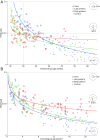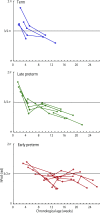Hemoglobin phase of oxygenation and deoxygenation in early brain development measured using fNIRS
- PMID: 28196885
- PMCID: PMC5338505
- DOI: 10.1073/pnas.1616866114
Hemoglobin phase of oxygenation and deoxygenation in early brain development measured using fNIRS
Abstract
A crucial issue in neonatal medicine is the impact of preterm birth on the developmental trajectory of the brain. Although a growing number of studies have shown alterations in the structure and function of the brain in preterm-born infants, we propose a method to detect subtle differences in neurovascular and metabolic functions in neonates and infants. Functional near-infrared spectroscopy (fNIRS) was used to obtain time-averaged phase differences between spontaneous low-frequency (less than 0.1 Hz) oscillatory changes in oxygenated hemoglobin (oxy-Hb) and those in deoxygenated hemoglobin (deoxy-Hb). This phase difference was referred to as hemoglobin phase of oxygenation and deoxygenation (hPod) in the cerebral tissue of sleeping neonates and infants. We examined hPod in term, late preterm, and early preterm infants with no evidence of clinical issues and found that all groups of infants showed developmental changes in the values of hPod from an in-phase to an antiphase pattern. Comparison of hPod among the groups revealed that developmental changes in hPod in early preterm infants precede those in late preterm and term infants at term equivalent age but then, progress at a slower pace. This study suggests that hPod measured using fNIRS is sensitive to the developmental stage of the integration of circular, neurovascular, and metabolic functions in the brains of neonates and infants.
Keywords: Hb; fNIRS; infant; neurovascular; preterm.
Conflict of interest statement
The authors declare no conflict of interest.
Figures











References
-
- Inder TE, Warfield SK, Wang H, Hüppi PS, Volpe JJ. Abnormal cerebral structure is present at term in premature infants. Pediatrics. 2005;115(2):286–294. - PubMed
-
- Fischi-Gómez E, et al. Structural brain connectivity in school-age preterm infants provides evidence for impaired networks relevant for higher order cognitive skills and social cognition. Cereb Cortex. 2015;25(9):2793–2805. - PubMed
Publication types
MeSH terms
Substances
LinkOut - more resources
Full Text Sources
Other Literature Sources

